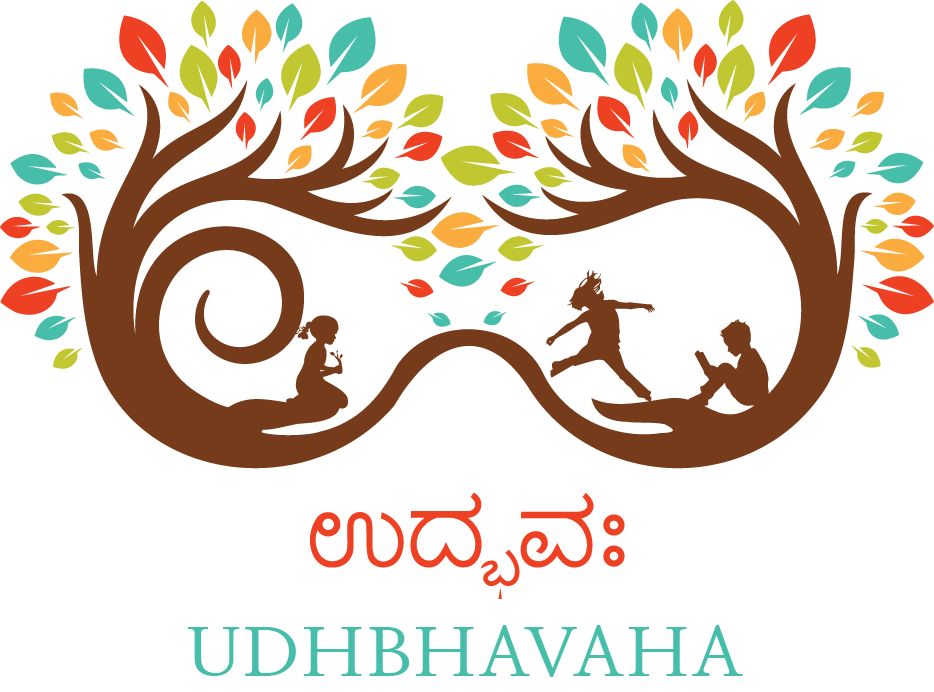
Curriculum and Pedagogy
Curriculum
Our work with children can be categorized as follows
Academics
Academics are established on a conceptual understanding of subjects, brought in through problem solving and projects. Math, Sciences, Social Sciences and languages are introduced as per the age-appropriate curriculum. Stories from scriptures and Puranas like Ramayana, Mahabharata, Panchatantra flow through the curriculum. For kids approaching teens, projects form the foundation of not just knowledge building, but life skills and overcoming internal barriers with courage and perseverance. Technology is offered at the right age. Kannada, Sanskrit, and English are the core languages that children focus on.
- Languages – Kannada, Samskrita, English
- Stories – Raja-Rani stories, Panchatantra, Bhagavatam, Dashavatara, Ramayana, Mahabharata
- Math
- Science
- Social Sciences
- Projects connected to the outside world
Aesthetics
“Kala is the hidden language of the soul.” Kala signifies beauty, expression, and bliss, children get the rasa (the essence of life) through this. Aesthetics and Kala are spun around each other. Children learn vocal and dance form that integrated with the experiences of folk culture forms the lifeline to connect to the rich culture of this nation.
- Carnatic vocal
- Bharatanatya
- Kalari
- Folk art
- Drawing/ Painting
- Handwork
- Woodwork
- Claywork
- Weaving
- Construction
- Theater
Aarogya
A healthy mind resides in a healthy body. Livelihood is defined as “means of securing basic necessities of life such as food, shelter, and clothes”. The next natural stride is the transition from livelihood to a sustainable livelihood. The primary prerequisite for the same is a healthy mind in a healthy body together with the development of the skills in children that will aid them to be self-dependent and interdependent
- Krishi
- Yoga
- Kreeda
- Ayurveda
- Cooking
Pedagogical Tools
Education of the head, heart, and hand
A holistic education of the child includes educating the head, heart, and hand. When the child learns through doing things practically or works on the farm, the will of the child develops. When the curriculum includes colors, stories and a sense of beauty in everything, the feeling realm of the child is nourished. Later, with the introduction of the concepts and exposing him to real-life projects, his thinking is enabled. With the thinking, feeling and willing faculties being developed, the child grows into a balanced adult, being in a better position to deal with life.
Anubhava (Experiences)
“The purpose of life is to live it, experience it, reach out eagerly and without fear for newer and richer experience.” Of what use is the intellectual knowledge when we can’t practice it judiciously and relevantly? Experiences play a major role in making an individual, sharpening the VIVEKA- the discretion to make the right choices in the crossroads of life.
These experiences are provided through travels, projects, samvaada, questioning, stories, and dhyaana – akarshane.
Travels – “With Age comes wisdom; with travel comes understanding”. The experience of adventure, observing and understanding how people live, seeing the connectedness in totality, exposure to myriad languages, dialect, food habits, culture and traditions and yet finding the common spirit, the humility, and gratitude to accept many things we have in abundance than some people, the change and transitions in nature and environment and adaptability to uncertainties during a journey – all these and more varied possibilities exist during these experiences of travel.
Samvaada (Dialogue) – In these present times, with the dearth of time and with increasing narrow-mindedness, our age-old tradition of samvaada or dialogue has almost vanquished despite the fact that the solutions to many problems lie in samvaada. A healthy dialogue and questioning, free expression clears doubt, allows to see many perspectives, creates a direction and lays the foundation of peace through churning (manthana). Through active and positive questioning, discussion on the stories from our scriptures, samvaada builds on. This brings in patience in listening, knowledge, and understanding, assimilation and inferring and is a very significant aspect of learning.
Dhyaana akarshane – getting the attention of the child to the truth behind everything around us. The topics could range from what is competition and comparison; the difference between want and need; food, taste, and health; decoding advertisements – what is it doing to an individual; deconstructing modernity and challenging the assumptions. Enabling the child to unearth the truth, lays the foundation for strong beliefs and new perspective building.
